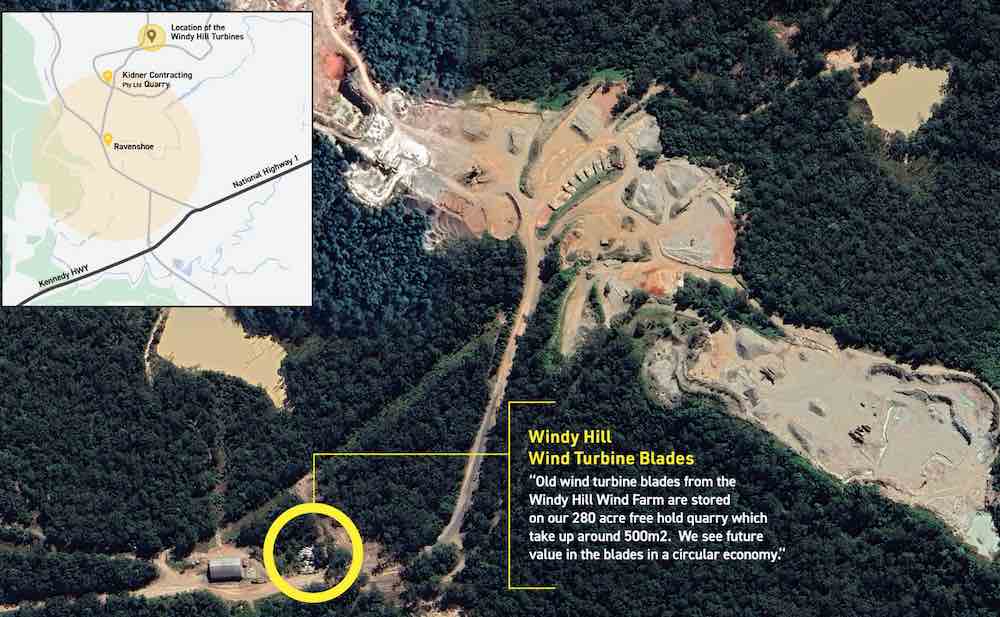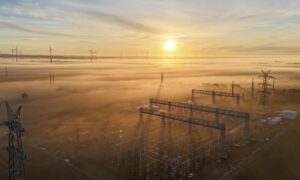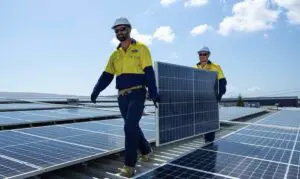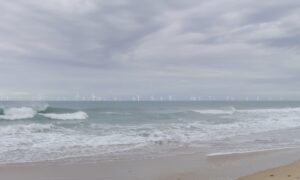Claims that decommissioned wind turbine blades have been secretly dumped in a shallow grave in a forest in far north Queensland have been thoroughly debunked this week – but not before being gobbled up by 2GB, Sky News, The Australian and various other Murdoch media mastheads.
The story spread via a video made by Nick Cater – executive director of the Menzies Research Centre, conservative columnist and would-be anti-renewables sleuth – that features him creeping through scrubland.
“I’m coming through here because I’ve been told there are old turbine blades that have been just dumped here,” Cater says against a soundtrack of cracking twigs and sombre piano.
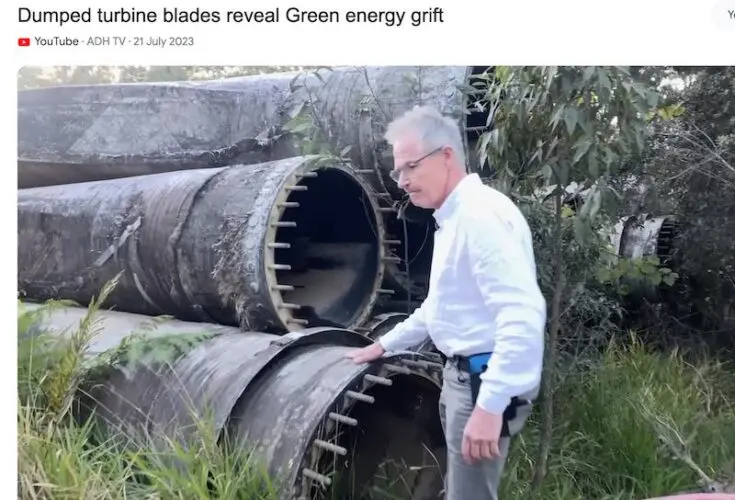
“Here they are,” Cater tells the camera, gravely, standing next to the old blades. “This is renewable energy, by the way. Remember that word, ‘renewable;’ there’s nothing much renewable about these.”
The video was received with glee by Sky and then a video of Sky’s delirious treatment of the story – “and we haven’t even started on solar!” – was republished in full by The Australian. News reports were also published in local Murdoch owned papers around Queensland.
It turns out, however, that the “forest” is actually the private property of local Ravenshoe business Kidner Contracting, and the turbine blades – from Queensland’s first ever wind farm, the 12MW Wind Hill project – are not so much dumped as stored there, instead of being sent to the tip.
“We have taken possession of disused wind turbine blades from the Windy Hill Wind Farm and are storing them on our 280 acre free hold quarry which take up around 500m2,” says Kidner Contracting managing director Blake Kidner in a statement forwarded to RenewEconomy.
“We see future value in the blades in a circular economy. These blades were destined for landfill, but we took possession of them and were stockpiled onsite as we have been working on ideas for reuse of them.
“Eight of these blades have been rehomed – two of them for trials for recycling options to CSIRO just last year, and the others for training purpose to repair them in-situ in NSW and VIC, so they don’t have to be removed for repair or be replaced if damaged, as other blades removed just get buried.”
Kidner says the “misinformation” pedalled in the video was illegally obtained by Cater, who was on the company’s property without permission.
“Nick Cater did not get any permission to enter our property, he has illegally obtained the footage, trespassed on our land,” Kidner says.
“The neat stockpile is not hidden in the forest. Nick’s political agenda does not show that there is a large shed and office within 100m of these, the camera man is standing on a quarry haul road.”
But Cater’s really not all that interested in the truth about the Windy Hill turbine blades, or Kidner’s motives for storing them.
The true aim of the video is to spread anti-renewables sentiment, more broadly, anti-wind energy sentiment, specifically, and anti-Chalumbin wind farm sentiment most specifically of all.
“This tells a story,” Cater says in the video, standing next to the ex-Windy Hill turbine blades. “One point four billion dollars for the Chalumbin wind farm and, in 15 years, they’ll just be sitting here like this.”
Ark Energy’s 600MW Chalumbin wind farm, proposed for near Ravenshoe in the state’s far north, has become the latest hobby horse of anti-wind lobby groups, whose efforts to derail Australia’s transition to renewables are becoming increasingly desperate.
Legitimate concerns about the project’s proximity to the adjacent Wet Tropics World Heritage Area last year saw it whittled back to less than half its original size, with 114 of the 200 turbines initially proposed cut from the plan to avoid sensitive ecological and cultural heritage sites.
Meanwhile, a dedicated community group set up in opposition to it, called Stop Chalumbin Wind Farm, has attracted well known anti-renewables politicians (Bob Katter, Gerard Rennick) and professional agitators (Cater) to its cause, which claims to be a battle of renewables vs nature and traditional owners.
Their efforts appear to be working. Just today, the ABC published a story on the project reporting that a group of traditional owners will go to Canberra “in a last-ditch effort to stop a controversial $1 billion wind farm from being built adjacent to World Heritage-protected rainforests in Far North Queensland.”
But the traditional owners of the land on which the project is being built, the Jirrbal People, are far from united against the project.
Last weekend, Jirrbal elder Brad Sam-Go, took out a full page in a range of Murdoch newspapers to declare his support for Chalumbin wind farm and to call out “misinformation being spread in the media.”
Sam-go says the Jirrbal Peoples “strongly support” the development of Chalumbin wind farm on their Country.
“It will bring opportunity for our peoples and help improve land that is now covered in weed and pests.
“The company has been working with us since 2019 to ensure they are respectful of Jirrbal Peoples’ connection to this area,” Sam-Go writes.
“The project is a win-win as we get local jobs on country and the environment gets a win too.
“If people want to oppose the wind farm for valid reasons they should be honest about it,” he continues. “But don’t misrepresent the truth and don’t misrepresent the views of the majority of the Jirrbal People. Our voice is our own.”
A media release issued on Thursday by the Wabubadda Aboriginal Corporation – the Registered Native Title Body Corporate that represents the interests of Jirrbal People – confirms its authorisation of the Chalumbin Wind Farm Area Indigenous Land Use Agreement.
“Whilst the details of the ILUA are confidential, the ILUA agreement includes mechanisms for protecting and preserving Jirrbal People’s cultural heritage and also has environmental protections,” the statement says.
And it adds, “All queries regarding matters affecting Jirrbal People’s Native Title rights and interests or cultural heritage interests should be directed to Wabubadda, in writing.”
The ABC speaks to Jirrbal woman Melita Asaki, who is opposed to the wind farm and will go to Canberra as part of a group, Including members of Rainforest Reserve Australia, to petition the federal environment minister Tanya Plibersek to reject the Chalumbin project.
Asaki tells the ABC that the Wabubadda Aboriginal Corporation does not represent all Indigenous people in the affected area. “They haven’t been out there and I don’t know who these people are,” she is quoted as saying.
In an email written in response to questions from the ABC reporter behind the story, seen by RenewEconomy, Ark Energy’s Anthony Russo says:
“It is my understanding from the NQLC [North Queensland Land Council, the Native Title Representative Body Aboriginal Corporation for the project area] that the ILUA with Jirrbal #4 People was subject to extensive consultation since 2019 and was authorised by majority on 7 May 2022.
“Like any group of represented people, there will be differing views amongst its constituents. We see this every day in local, state and federal governments. Governance is a matter for those organisations representing their constituents.”
This does not make it into the ABC story.

